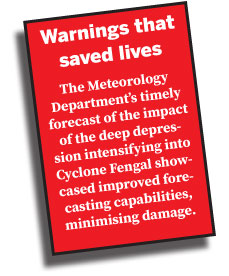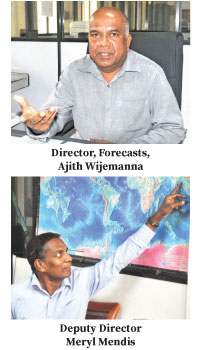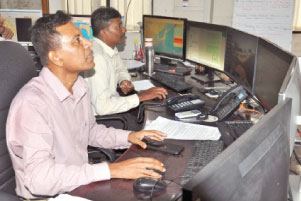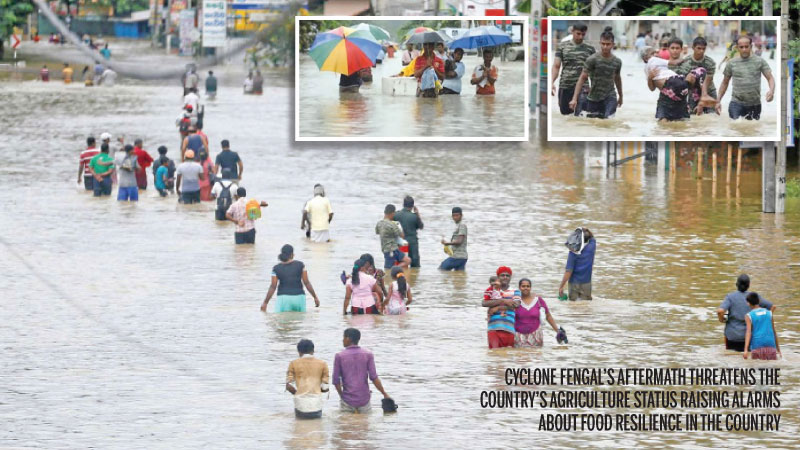The country is reeling from widespread devastation as Cyclone ‘Fengal’ has left a trail of destruction in its wake.
 The heavy rains and storms unleashed by cyclone ‘Fengal’ which intensified from a deep depression in the Bay of Bengal, have battered Sri Lanka over the past week, causing widespread disarray. The resulting floods have devastated infrastructure, roads, bridges, homes, hospitals, places of worship and some vehicles have also been badly damaged. Lives and livelihoods across the country have been disrupted, highlighting the storm’s catastrophic impact.
The heavy rains and storms unleashed by cyclone ‘Fengal’ which intensified from a deep depression in the Bay of Bengal, have battered Sri Lanka over the past week, causing widespread disarray. The resulting floods have devastated infrastructure, roads, bridges, homes, hospitals, places of worship and some vehicles have also been badly damaged. Lives and livelihoods across the country have been disrupted, highlighting the storm’s catastrophic impact.
At the time of writing, Cyclone ‘Fengal’ was moving West-Northwestward with wind speeds of 70 to 85 km/h. As of 11.30 p.m. yesterday, it was approximately 360 km North of Trincomalee and 280 km Northeast of Kankesanthurai, poised to make landfall along the Tamil Nadu-Puducherry coast on November 30, as forecast by the Indian Meteorological Department, Sri Lanka’s Department of Meteorology and international agencies such as the World Meteorological Organization (WMO) and the Japan Meteorological Agency (JMA).
Borne the brunt
The entire country, especially the Northern, Central and Eastern Provinces have borne the brunt of the storm’s fury with entire communities being submerged and critical infrastructure being destroyed .The disaster highlights the urgent need for the Government to act swiftly to address not only immediate relief efforts but also the broader implications of such climate-induced destruction. It is essential that climate change studies, reports and action plans—currently languishing on bureaucratic shelves—be put into action. With the nation facing the challenges of economic recovery and climate adaptation, the Government must prioritise the implementation of these plans to protect citizens from future catastrophes.
 The global dimension of climate change cannot be ignored either. As these extreme weather patterns become more frequent, Sri Lanka must engage with international agencies and hold accountable the global community’s role in combatting the drivers of climate change.
The global dimension of climate change cannot be ignored either. As these extreme weather patterns become more frequent, Sri Lanka must engage with international agencies and hold accountable the global community’s role in combatting the drivers of climate change.
The country has yet to make significant progress in modelling the long-term impact of climate change. Broader studies conducted for the South Asian region reveal a rise in extreme weather, including heat waves and intense rainfall. Forecasts also warn of an increase in tropical cyclonic activity, like the storm that battered the country last week, amplifying risks to the region.
The cost
A report by the World Meteorological Organization (WMO) last year painted a grim picture of the situation in Asia. In 2022 alone, the region experienced 81 weather, climate, and water-related disasters with over 83 percent being floods and storms. These disasters claimed more than 5,000 lives, directly affected over 50 million people and caused economic damage exceeding US dollars 36 billion worldwide.
The authorities must not take this lightly. Although Sri Lanka is not a high carbon-emitting country compared to nations such as the United States or Canada, it remains highly vulnerable to the adverse effects of climate change driven by emissions from other countries.
The highest carbon-emitting nations include China, the United States, India and the European Union. China takes the lead in this regard, contributing more than a quarter of the world’s global emissions. The U.S. and India follow right behind with significant shares, while the EU collectively emits less but has ambitious climate goals.
 Many of these nations have committed to reducing emissions by setting net-zero targets. China aims for carbon neutrality by 2060, the U.S. by 2050 and India by 2070. These nations are also signatories of international agreements such as the Paris Agreement to provide financial resources to lower Green House Gas (GHG) emissions and climate-resilient development.
Many of these nations have committed to reducing emissions by setting net-zero targets. China aims for carbon neutrality by 2060, the U.S. by 2050 and India by 2070. These nations are also signatories of international agreements such as the Paris Agreement to provide financial resources to lower Green House Gas (GHG) emissions and climate-resilient development.
The world’s highest carbon-emitting nations – China, the US, India and the European Union – are central to the global debate on climate responsibility. China accounts for more than a quarter of global emissions, followed by the U.S. and India with significant shares. The European Union, while emitting less in total, has set ambitious climate goals aimed at reducing its carbon footprint. These nations have graciously committed to reaching net-zero emissions—China by 2060, the U.S. by 2050, and India by 2070. They are also signatories of international agreements such as the Paris Agreement which promises to provide financial support for low-emission development and climate resilience.
However, this does not mean that Sri Lanka and other developing countries should be left suffering the consequences and bearing the brunt of climate change so that these high-emission nations can meet their targets without too much disruption to their business-as-usual routine.
Sri Lanka is a partner to the Paris Agreement on climate change and signed it on September 7, 2016 after Parliament unanimously approved it. The country has committed to reducing greenhouse gas emissions in line with global efforts to limit temperature rise to below 2°C compared to pre-industrial levels.
Breakthrough
At COP27 in 2022, a breakthrough was made with the creation of the Loss and Damage fund, designed to support developing nations bearing the brunt of climate-related disasters. This fund acknowledges the financial burden low carbon emission countries face. Denmark has already pledged direct financial assistance to vulnerable countries.
The wealthier nations have been hesitant to make large financial commitment fearing that it could lead to liability and additional compensation claims. Meanwhile, developing countries in Asia continue to bear the brunt of destruction caused by climate change-induced disasters. The countries vulnerable to increasingly frequent and severe weather patterns, have long called for compensation from high carbon-emitting nations.
At the COP27 climate conference in 2022, a ‘Loss and Damage’ fund was set up to provide financial assistance to developing countries facing the worst impact of climate-related disasters. This fund is a recognition of the significant financial burden these countries shoulder.
A new report from the World Meteorological Organization (WMO), part of its regional State of the Climate series was released during a meeting of the UN Economic and Social Commission for Asia and the Pacific (ESCAP). The report highlights the growing impact of climate-related disasters in Asia, the world’s most disaster-prone region.
Armida Salsiah Alisjahbana, Under-Secretary-General of the United Nations and Executive Secretary of ESCAP, emphasised the importance of the UN Secretary-General’s ‘Executive Action Plan on Early Warnings for All’, co-led by WMO and the UN Office for Disaster Risk Reduction (UNDRR). This plan is increasingly critical in Asia where trans-boundary climate disasters are on the rise.
The report also features an interactive story map, focusing on agriculture and food security. It warns that the expected increase in extreme weather will significantly affect agriculture, a key area for climate adaptation efforts in the region.
No matter how sophisticated an early warning system is, the best it can do is prevent the loss of life. When it comes to vegetable and paddy cultivation, however, the situation is far more complex. After all, it’s not like the farmers can simply pick up their vegetable nurseries and paddy fields and move them out of harm’s way when floods are approaching. Imagine the logistics of such a situation—just move the whole farm to a safer location! If only cultivation was that simple. Instead, these farmers are left to watch as their crops are inundated and uprooted, while the world debates the effectiveness of warnings that can’t halt nature’s fury from sweeping away livelihoods.
Cyclone Fengal’s aftermath threatens Sri Lanka’s agriculture, raising alarms about the region’s food resilience. More than 64,000 hectares of paddy in the Northern Province has been destroyed by floods, with the Mannar district where suffering the most extensive damage of 23,000 hectares have been completely destroyed.
Director General of the Irrigation Department Eng. A. Gunasekara who visited flood-hit Batticaloa, Ampara, and Trincomalee said on Friday that he had observed more than 20 percent of the paddy fields went under water due to rivers and reservoirs overflowing in the Northern and Eastern Provinces. This means that farmers in these districts will not be able to cultivate or reap a paddy harvest in the Maha season.
 The Government is taking steps to compensate paddy farmers, vegetable farmers and farmers of other crops for crop damage. While the adverse weather is now dissipating, the Government is looking after over 463,569 people of 138,191 families in 24 disaster-hit districts in the country. They were hit by floods, tree falls, strong winds and earthslips. According to the Disaster Management Centre (DMC) 15 people have been killed, 20 injured and one has gone missing due to rain-related disasters which affected the country from November 22.
The Government is taking steps to compensate paddy farmers, vegetable farmers and farmers of other crops for crop damage. While the adverse weather is now dissipating, the Government is looking after over 463,569 people of 138,191 families in 24 disaster-hit districts in the country. They were hit by floods, tree falls, strong winds and earthslips. According to the Disaster Management Centre (DMC) 15 people have been killed, 20 injured and one has gone missing due to rain-related disasters which affected the country from November 22.
Recent weather patterns highlighted the limitations of the Meteorology Department’s forecasting. For example, in October 2024, unexpected rainfall intensified in areas where it was anticipated to decrease. While forecasts showed a reduction, the rains continued catching many off guard.
The Department is often under fire for inaccuracies in forecasting localised weather. This time around, it achieved a significant milestone with its timely forecast of Cyclone Fengal’s impact. On November 19, the Department forecast the formation of a deep depression in the Bay of Bengal and it intensifying into Cyclone Fengal, providing early warnings of the heavy rains and floods that would batter the island on November 26 and 27.
Deep depression
The Meteorology Department’s timely forecast of the impact of the deep depression intensifying into Cyclone Fengal showcased improved forecasting capabilities; minimising potential damage. This marks a shift from past criticisms of delayed technology adoption and inconsistent forecasts, showcasing a growing competence in anticipating extreme weather. The Department’s near-accurate forecasts allowed the local authorities and communities to prepare in advance, minimising potential risk and damage.
When asked about this success, Ajith Wijemanna, Director of the Forecast and Early Warnings Department and Deputy Director Meryl Mendis attributed it to the use of numerical weather models. This forecasting method, which integrates complex atmospheric data to simulate weather patterns, played a pivotal role in providing precise and timely warnings, he said.
The Meteorology Department reported that the depression was located approximately 130 kilometres east of Trincomalee on Thursday, bringing rainfall exceeding 200mm to many regions. Landslide risks remained high, with the National Building Research Organisation issuing red alerts for Kandy, Matale and Nuwara Eliya districts.
The DMC took emergency measures where Army and Navy personnel were deployed for rescue and relief operations. Efforts included assisting children sitting the Advanced Level examinations to reach their examination centres. Now, with the situation taking a turn for the worse, these examinations have been postponed for December. A hotline has been set up by the Sri Lanka Police and the Disaster Management Centre to coordinate support for affected communities.
Earlier, as the storm was intensifying the authorities urged residents in vulnerable areas to remain alert and take precautions.
Sri Lanka is to receive two Doppler radar systems by 2026, funded by Japan which will help the Department to monitor rainfall intensity and forecast flash floods even more effectively. These systems will allow for real-time detection of weather patterns, enabling better planning and response
Despite these efforts, the Department’s existing infrastructure has faced criticism for delays with some accusing it of having abandoned crucial equipment that could have improved forecasting
This complex issue reflects the broader challenge faced by meteorological agencies globally, where rapid changes in weather patterns driven by climate change have outpaced traditional forecasting methods.
Food resilience
Food resilience has emerged as a critical focus in Asia, especially in light of the increasing impact of climate change on agriculture. This priority is prominently reflected in the Nationally Determined Contributions (NDCs) submitted by many parties to the Paris Agreement, particularly among WMO Member states within the Regional Association II.
These NDCs highlight the need for robust strategies to ensure food security amidst changing weather patterns. A cornerstone of these strategies is the integration of climate monitoring and forecasting systems. By analysing historical and current climate trends and generating weather forecasts on short to long timescales, countries can bolster early warning systems tailored for agriculture. Such tools are essential for guiding farmers, policymakers, and disaster management teams in mitigating the adverse effects of climate variability on crop production and food supply chains.
The emphasis on resilience also aligns with global calls to use meteorological advances, such as numerical prediction models and real-time monitoring, to support sustainable and adaptive agricultural practices. This approach they say is expected to safeguard the livelihoods of millions dependent on agriculture across the region.
Coastal areas
Cyclone Fengal which was a developing system in the Bay of Bengal was expected to make landfall between Tamil Nadu and Puducherry in southern India on November 30, 2024. Currently categorised as a deep depression, the system is intensifying into a cyclonic storm, bringing forecasts of heavy rainfall and strong winds. Coastal areas in the region are on high alert, with warnings of wind speeds reaching 70 kilometres per hour and potential flooding.
The cyclonic storm was near Sri Lanka’s Northern Province on Thursday morning and was approximately 120 kilometres East of Trincomalee. It is moving further Northwards away from the country. The rains could persist in the Northern region for a few more days, according to officials of the Meteorology Department.
Pix by Sudath Malaweera







